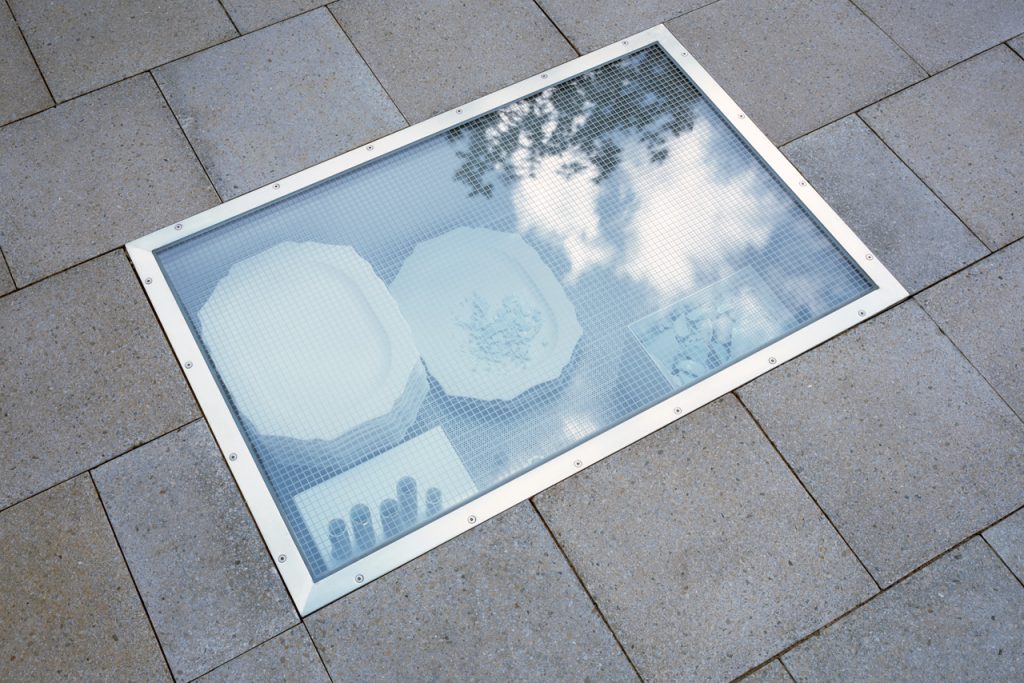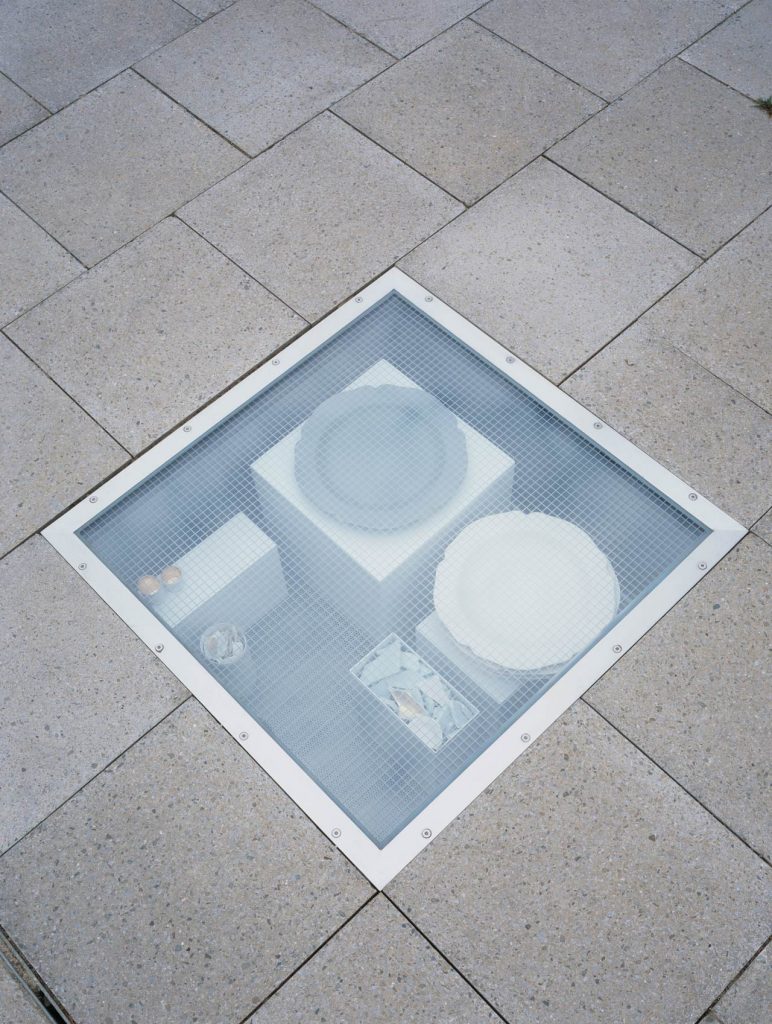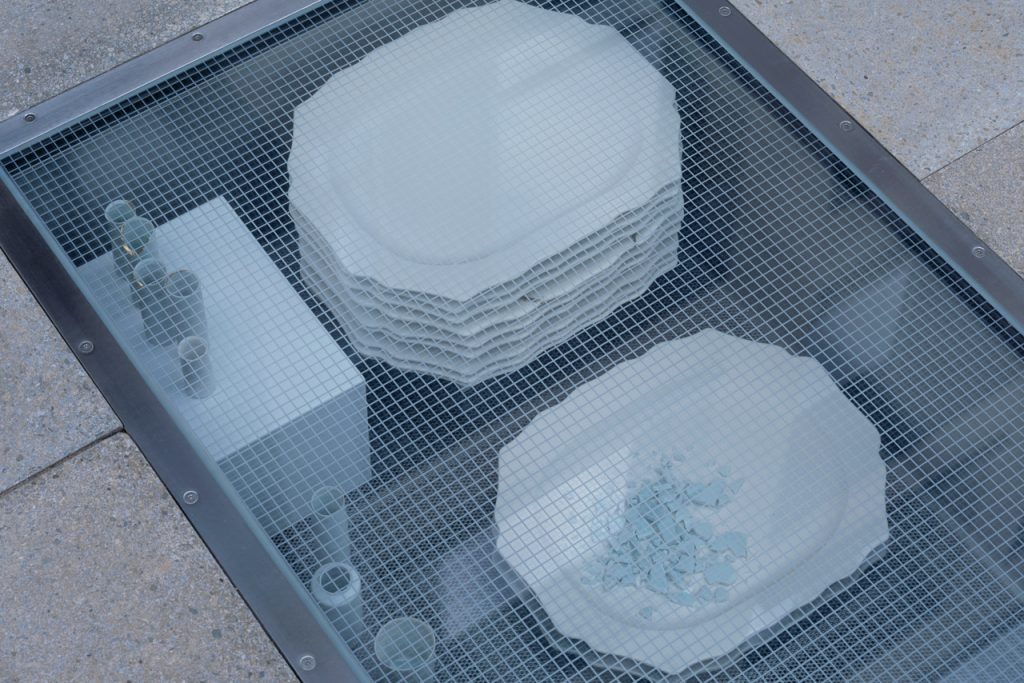‘A Local History’ is a permanent installation of three vitrines filled with porcelain, sunk below the paving outside the Alison Richard Building on the Sidgwick Site of Cambridge University. These vitrines are meant to be discovered, to be happened upon as you come and go across the site. They are there to make you pause momentarily. They are not sculpture as a Grand Statement.
If you find them and look down through the gridded glass you will see piles of porcelain dishes, cylinders arranged in rows, and aluminium boxes filled with shards. The dishes are taken from moulds that I made from a Chinese Ming Dynasty dish, a plate from the French Sèvres porcelain factory, and a Staffordshire serving dish. These three dishes are iconic in form: they exemplify porcelain from three of the greatest places where it has been manufactured over the last thousand years. You will see that these pieces are glazed in whites, creams and celadons, and that there are also glimpses of gilding. Gold was used to highlight the value of porcelain, a material so prized that it was often called white gold. It was also used in Chinese and Japanese art when a vessel had been broken: to mend the porcelain with a seam of golden lacquer emphasized that it had been used and appreciated. I hope the flashes of gold, the fragments of broken vessels and the memories of ancient dishes act as a kind of palimpsest: a writing, erasing, and rewriting using objects.
If you look up inside the atrium of the building you will see another vitrine, this time full of shelves holding celadon vessels. This vitrine, atlas, is my record of lost pots. It holds 120 lids from lidded jars that I have made over the last twenty years and broken because they were not quite right, because the glaze ran, because of a crack along a rim. If the structure of the vitrine looks familiar, it is because it is a gentle echo of a manuscript page with texts, footnotes and commentaries in intimate conjunction.
All these vitrines are a kind of archive. They record my thinking about the history of porcelain, my travels, my love of fragments, my obsession with shadows, my reading. They are for this particular place – a threshold into a building, and a threshold into a site full of libraries and archives, and the people who care about libraries and archives.
About Edmund de Waal
Edmund de Waal is one of the world’s leading artists working in ceramics today. He is best known for his large-scale installations of porcelain vessels, with interventions at Waddesdon Manor, the Victoria & Albert Museum, Tate Britain and MIMA. Much of his recent work has been concerned with ideas of collecting and collections: how objects are kept together, lost, stolen, or dispersed.
Increasingly, Edmund’s work has come from a dialogue between minimalism, sound and space, seen in his two permanent installations: Signs & Wonders at the V&A and a sounding line at Chatsworth House. In September 2012, Edmund will take his work beyond the museum space in his first piece of public sculpture, a local history, to be installed at the new Alison Richard’s Building at the University of Cambridge. Other future projects include working with the Chinese porcelain collections at the Fitzwilliam Museum, for an exhibition opening in February 2013, and a collaborative project with the Rijksmuseum, Amsterdam.
Edmund is also widely known as a writer. In 2010, Chatto & Windus published his family memoir, The Hare with Amber Eyes, which has become an international bestseller. It has won many literary prizes, including the Costa Biography Award, the Galaxy New Writer of the Year Book Award and the Royal Society of Literature Ondaatje Prize. By 2013, it will be published in over twenty-three languages. In 2011 Edmund was commissioned by Phaidon to write The Pot Book, a colour-illustrated anthology of 300 ceramic vessels. His other publications include a monograph on Bernard Leach (1997) and a survey of 20th Century Ceramics (2003).
Edmund was appointed a Trustee of the V&A and awarded an OBE for his services to art in 2011. In June 2012, he was made a Senior Fellow at the Royal College of Art.
Edmund was born in Nottingham in 1964. During his school years in Canterbury, he was apprenticed to the potter Geoffrey Whiting. After reading English at Cambridge, Edmund spent a further year studying at the Mejiro Ceramics Studio in Tokyo. He lives and works in London.

Edmund de Waal, A Local History 




Photography © Edmund de Waal & Helene Binet